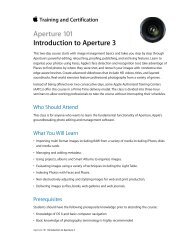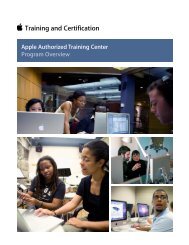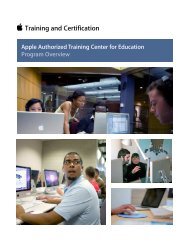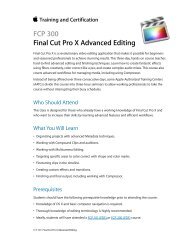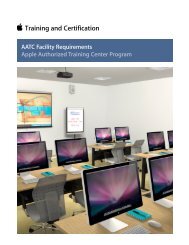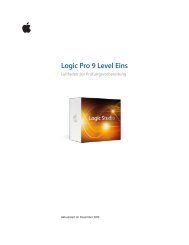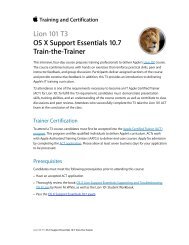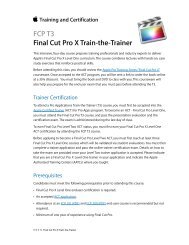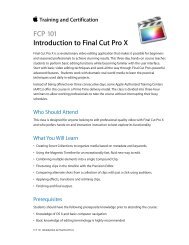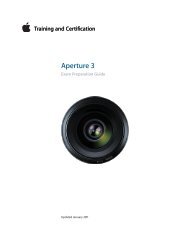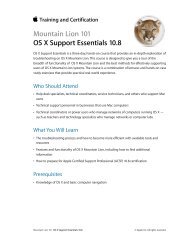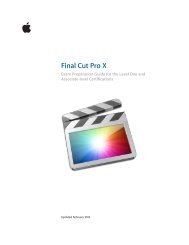OS X Support Essentials 10.8 - Training - Apple
OS X Support Essentials 10.8 - Training - Apple
OS X Support Essentials 10.8 - Training - Apple
Create successful ePaper yourself
Turn your PDF publications into a flip-book with our unique Google optimized e-Paper software.
<strong>OS</strong> X <strong>Support</strong> <strong>Essentials</strong> <strong>10.8</strong> Exam Preparation Guide<br />
Part Four: Data Management<br />
Upon completion of Part Four, “Data Management” in <strong>OS</strong> X Mountain Lion<br />
<strong>Support</strong> <strong>Essentials</strong>, you should be able to complete the following tasks. Ten<br />
items from Part Four are included in the pool of exam questions. Questions<br />
are drawn randomly from the following objectives:<br />
• Given a Mac with <strong>OS</strong> X installed, manage user and system files.<br />
• Compare and contrast the features and functions of aliases and links as<br />
implemented in <strong>OS</strong> X.<br />
• Describe the tools and methods used to create aliases and links.<br />
• Describe the structure and purpose of the <strong>Apple</strong>Double metadata<br />
format.<br />
• Describe the tools and methods used to navigate to and view the<br />
contents of hidden folders in the Finder.<br />
• Describe the tools and methods used to install fonts.<br />
• List the four default top-level folders visible in the Finder: Applications,<br />
Library, System, and Users.<br />
• Describe the types and function of metadata as it applies to the file<br />
system.<br />
• Compare and contrast the System, Local, User, and network domains,<br />
including what resources are stored in each, and the order in which<br />
<strong>OS</strong> X searches for resources in the file system.<br />
• Describe <strong>OS</strong> X extended attributes, and give one example of<br />
information the system keeps as an extended attribute.<br />
• Compare and contrast these file types: extensions, frameworks, fonts,<br />
preferences, startup items, and logs.<br />
• Compare and contrast file system packages and bundles, and their<br />
purposes.<br />
• Identify where each of these file types are located in the file system:<br />
extensions, frameworks, fonts, preferences, startup items, and logs.<br />
• Describe how Spotlight metadata is used in <strong>OS</strong> X.<br />
• Describe how and why the Finder hides certain folders by default.<br />
• Identify potential privacy and security issues with Spotlight.<br />
• Describe where metadata indexes and plug-ins are stored in the <strong>OS</strong> X<br />
file system.<br />
• Given a Mac with <strong>OS</strong> X installed, archive files.<br />
• Describe the tools and methods used to manage a zip archive of<br />
selected items in the Finder.<br />
• Compare and contrast disk images created with Disk Utility and zip<br />
archives created by the Finder in <strong>OS</strong> X.<br />
• Describe the options available when creating a new blank image using<br />
Disk Utility in <strong>OS</strong> X.<br />
• Given a Mac with <strong>OS</strong> X installed, configure and manage Time Machine.<br />
22



